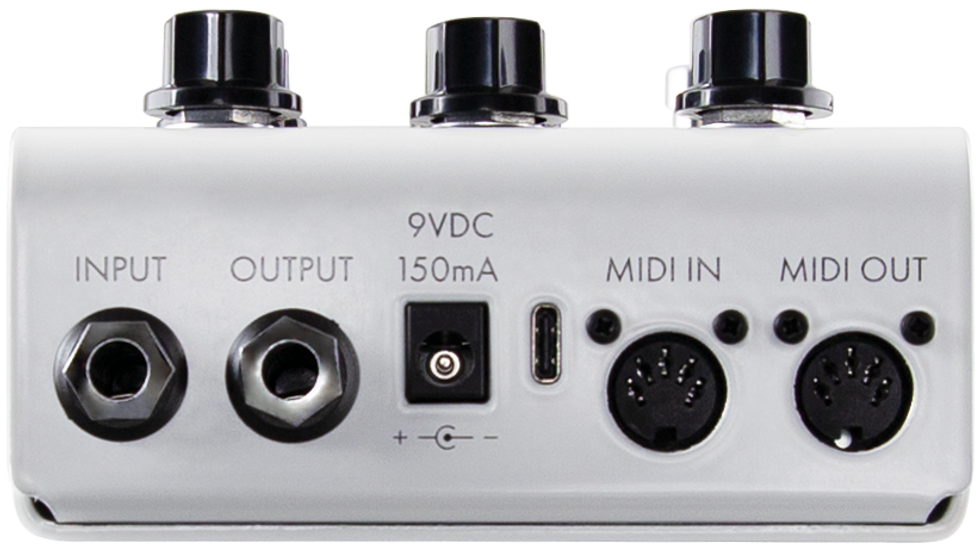I usually keep three dirt pedals on my main board. You might have more. Lots of dirt options are fun! But what we gain in tonal variety from such set ups, we lose in valuable pedalboard space. The RJM Overture, an all-analog, digitally controlled programmable overdrive pedal with six distinct modes, offers a viable solution to this problem that doesn't skimp on the sounds.
Six Slick Drives
As varied as the Overture can be, the main control layout is pretty straight ahead. There are knobs for gain, volume, bass, treble, and pre-boost. Just below those knobs you can select from the Overture's modes—clean boost, classic, boutique, versatile, smooth, and crunch—by using a small button. The two footswitches are on/off and solo. The latter switch, which is called "bank" in the newest production run, lets you select from preset banks 1-4 when disengaged or 5-8 when engaged. The bank switch effectively lets you switch between two presets in the two different banks.
Ernie Ball/Music Man Axis Sport and a Fender Super-Sonic combo for both clips.
Clip #1 - Classic Gain 3 - 00, Treble (Tone) 11 - 00, Volume 12 - 00, Pre - Boost OFF
Clip #2 - Crunch Gain Max, Bass 1 - 00, Treble 11 - 00, Volume Noon. Pre - Boost Off
The Overture's programmability is a big part of its convenience. The unit allows up to eight presets. And if you really want to geek out and stretch the Overture's potential, you can use the pedal's MIDI functionality and, with an external controller, can store up to 100 additional presets and control parameters. The programmable aspect of the Overture isn't immediately intuitive and I had to consult the manual to get up and running. But in general, it's fairly simple once you learn how it works.
I got rounder, slightly softer transients, but a big buttery sound that was more than a little Dumble-like.
To access presets 1 though 4, you have to press the on/off and solo buttons simultaneously to scroll. To access presets 5 through 8, you press the solo button again to select that bank of presets, then scroll with the on/off and solo buttons. To save changes, you hold down the overdrive mode mini-button for three seconds, and it will save to the selected preset location.

To access a specific preset within a bank, you have to scroll through all the presets sequentially in ascending order. So you can't quickly switch from, say, preset 2 to 1. You have to scroll all the way from 2 through 4 before reaching 1 again. To get the most out of the Overture, it's worth looking into integration with one of the excellent MIDI foot controllers in RJM's product line.
Overdriven Overture
While space in this review doesn't permit covering all six Overture modes in depth, there are distinct highlights. Three of the modes—classic, boutique, and versatile—are based on TS and modified TS circuits. In classic and boutique mode, the bass knob is inactive and the treble knob functions like the single tone control on a TS. With the gain around 11 o'clock and the treble knob at noon, classic mode generates very sweet lead voices that are open and refreshingly robust in the low end for Tube Screamer-style stomps, which are famous for their midrange. It also sounded more articulate and spacious than many original Tube Screamers I have heard. The versatile mode is similar to the boutique mode, but its active bass control permits more tone-shaping flexibility. Switching to smooth mode with the same settings (and the bass control active and set at noon), I got rounder, slightly softer transients, but a big buttery sound that was, surprisingly, more than a little Dumble-like.
Engaging the clean boost with pre-boost at noon (the pre-boost control allows up to 12 dB of pre-overdrive boost) and gain set low coaxed stinging bluesy tones from single-coils. At the same settings, bridge humbuckers generated beautiful clean rhythm tones. And even a basic open-position G chord sounded majestic and responded dynamically to extra pick attack, with rich overdrive breakup.
The Verdict
It's hard to find a bad sound in the Overture. Even at lower gain settings, the pedal shines—lending a bright, lively edge to basic guitar tones. If all you need is a single overdrive pedal, this might be overkill. But if a single OD leaves you wanting, the Overture can make a lot of high-quality overdrive sounds without taking up a ton of space.





















